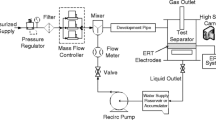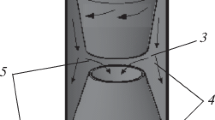Abstract
The separation of two-phase flow is essential for many fluid systems in microgravity environments. The passive cyclonic separator is a prominent technology for this task. In the absence of gravity, the separators can operate in different parametric ranges than in normal gravity. The objective of the present investigation is to better understand the fluid physics involved in two-phase flow separation in microgravity by deriving the basic scaling laws for various important parameters. Combined approaches of control-volume analysis and numerical simulations are used to construct a system of equations that can accurately predict the gas core size under various conditions. The predictions are found to be in good agreement with the experimental data, both for pure liquid injection and two-phase flow injection cases. The control-volume equations are modified to include capillary effects and predict the critical condition for the collapse of the liquid layer in microgravity as the surface tension overcomes the centrifugal acceleration at the interface. It is shown that the results of the control-volume analysis can also be used to construct the operational map and to study the separation of a single bubble in microgravity.
Graphical abstract
























Similar content being viewed by others
Abbreviations
- \({A_{\textrm{gap}}}\) :
-
Total cross-sectional area of the gap (m\(^2\))
- \({A_{\textrm{inj}}}\) :
-
Injector area (m\(^2\))
- \({A_{\textrm{out}}}\) :
-
Area of the gap between the baffle plate and separator wall (m\(^2\))
- As :
-
Separator aspect ratio
- \({C_\alpha }\) :
-
Compression coefficient
- \({C_f}\) :
-
Skin friction coefficient
- \({F_s}\) :
-
Volumetric surface tension force (kg/(m\(^2\) \(\cdot \) s\(^2\) )
- g :
-
Gravitational acceleration (m/s\(^2\))
- \({J_{in}}\) :
-
Angular momentum at the inlet (\(\textrm{kg} \cdot {\textrm{m}^2}/{\textrm{s}^2}\))
- \({J_{\textrm{loss}}}\) :
-
Angular momentum loss (\(\textrm{kg} \cdot {\textrm{m}^2}/{\textrm{s}^2}\))
- \({J_{\textrm{out}}}\) :
-
Angular momentum at the outlet (\(\textrm{kg} \cdot {\textrm{m}^2}/{\textrm{s}^2}\))
- \({J_r}\) :
-
Angular momentum ratio between the inlet and the outlet
- \({K_g}\) :
-
Generalized backpressure coefficient for gaseous flow (\(1/{\textrm{m}^4}\))
- \({K_l}\) :
-
Generalized backpressure coefficient for liquid flow (\(1/{\textrm{m}^4}\))
- L :
-
Separator length (m)
- \(\vec {n}\) :
-
Unit normal vector of the interface
- \({p_d}\) :
-
Modified pressure (\(\textrm{kg}/({\textrm{m} \cdot {\textrm{s}^2}} )\))
- Q :
-
Inlet volumetric flow rate (m\(^3\)/s)
- \({Q_g}\) :
-
Gas flow rate (liter per minute)
- \({Q_l}\) :
-
Liquid flow rate (liter per minute)
- r :
-
Dimensionless radial location
- \({r_i}\) :
-
Dimensionless gas core radius
- \({r_{i\infty }}\) :
-
Dimensionless gas core radius when surface tension is negligible
- \(r_i^*\) :
-
Ratio of \({r_i}\) and \({r_{i\infty }}\)
- Re :
-
Reynolds number based on separator radius
- \(R{e_f}\) :
-
Film Reynolds number
- R :
-
Radial location (m)
- \({R_0}\) :
-
Separator radius (m)
- \({R_B}\) :
-
Radial distance between the bubble and the separator axis (m)
- \({R_b}\) :
-
Bubble radius (m)
- \({R_i}\) :
-
Gas core radius (m)
- \({R_{ij}}\) :
-
Reynolds stress (\(\textrm{kg}/({\textrm{m} \cdot {\textrm{s}^2}} )\))
- S :
-
Swirl number
- t :
-
Time (s)
- u :
-
Dimensionless characteristic liquid tangential velocity
- U :
-
Flow velocity (m/s)
- \({U_0}\) :
-
Characteristic axial velocity (m/s)
- \({U_l}\) :
-
Liquid tangential velocity (m/s)
- \({U_{l,i}}\) :
-
Liquid tangential velocity at the interface (m/s)
- \({u_l}\) :
-
Dimensionless liquid tangential velocity
- \({u_{l,\textrm{av}}}\) :
-
Average dimensionless liquid tangential velocity across the gap
- \({U_{l,\textrm{inj}}}\) :
-
Liquid velocity at the injector (m/s)
- \({U_{ls,\textrm{inj}}}\) :
-
Liquid superficial velocity at the injector (m/s)
- \({U_r}\) :
-
Interface compression velocity (m/s)
- \({U_\theta }\) :
-
Characteristic liquid tangential velocity (m/s)
- \({U_z}\) :
-
Liquid axial velocity (m/s)
- \({u_z}\) :
-
Dimensionless liquid axial velocity
- \({u_{z,\textrm{av}}}\) :
-
Average dimensionless liquid axial velocity across the gap
- \({V_r}\) :
-
Bubble velocity in radial direction (m/s)
- \({V_z}\) :
-
Bubble velocity in axial direction (m/s)
- \(W{e_0}\) :
-
Injection Weber number
- \(W{e_i}\) :
-
Interfacial Weber number
- \(W{e_m}\) :
-
Modified Weber number
- \(W{e_{m,\textrm{cr}}}\) :
-
Critical modified Weber number
- x :
-
Position vector
- \(\alpha \) :
-
Gas volume fraction at the injector
- \({\alpha _l}\) :
-
Liquid volume fraction
- \(\beta \) :
-
Gas volumetric quality of the mixture at the injector
- \(\Delta {p_{\textrm{film}}}\) :
-
Pressure change in the liquid film (\(\textrm{kg}/({\textrm{m} \cdot {\textrm{s}^2}})\))
- \(\Delta {p_g}\) :
-
Pressure drop at the gas outlet (\(\textrm{kg}/(\mathrm{{m} \cdot {\textrm{s}^2}})\))
- \(\Delta {p_l}\) :
-
Pressure drop at the liquid outlet (\(\textrm{kg}/({\textrm{m} \cdot {\textrm{s}^2}})\))
- \(\Delta p_{\textrm{max}}^*\) :
-
Dimensionless maximum pressure at the separator wall
- \(\Delta p_{\textrm{max},\infty }^*\) :
-
Dimensionless maximum pressure at the separator wall when surface tension is negligible
- \({{\Gamma }}\) :
-
Area ratio between the separator cross section and the injector
- \(\kappa \) :
-
Surface curvature (1/m)
- \({\kappa _g}\) :
-
Dimensionless gas outlet backpressure coefficient
- \({\kappa _l}\) :
-
Dimensionless liquid outlet backpressure coefficient
- \(\sigma \) :
-
Surface tension (N/m)
- \(\tau \) :
-
Viscous stress (\(\textrm{kg}/({\textrm{m} \cdot {\textrm{s}^2}})\))
- \({\tau _t}\) :
-
Turbulent stress (\(\textrm{kg}/({\textrm{m} \cdot {\textrm{s}^2}})\))
- \({\tau _w}\) :
-
Wall shear stress (\(\textrm{kg}/({\textrm{m} \cdot {\textrm{s}^2}})\))
- \({\mu _g}\) :
-
Gas dynamic viscosity (\(\textrm{kg}/({\textrm{m} \cdot \textrm{s}})\))
- \({\mu _l}\) :
-
Liquid dynamic viscosity (\(\textrm{kg}/({\textrm{m} \cdot \textrm{s}})\))
- \(\rho \) :
-
Mixture density (kg/m\(^3\))
- \({\rho _g}\) :
-
Gas density (kg/m\(^3\))
- \({\rho _l}\) :
-
Liquid density (kg/m\(^3\))
References
McQuillen, J., Sankovic, J., Hall, N. R.: Multiphase flow separators in reduced gravity. In: Proc. Fluid Eng D, pp. 737–743
Ghrist, M., Ellis, M., Bean, D., Kurwitz, C., Best, F.: Microgravity phase separation for the Rankine cycle. Nucl. Technol. 156(3), 282–288 (2006)
McQuillen, J., Rame, E., Kassemi, M., Singh, B., Motil, B.: Results of the workshop on two-phase flow, fluid stability and dynamics: issues in power, propulsion, and advanced life support systems. NASA Technical Report No. E-14154 (2003)
Fleeter, S., Ostrach, S.: Liquid Gas Cyclone Separation. AFOSR Technical Report No. 66-1400, Case Institute of Technology (1966)
Hoyt, N.C., Kang, M.F., Lee, K.L., Kharraz, A., Kadambi, J., Kamotani, Y.: Study of steady and dynamic behavior of gas core of passive cyclonic separator for space applications. Microgravity Sci. Tec. 25(3), 187–200 (2013)
Kang, M.F., Hoyt, N.C., Kadambi, J., Kamotani, Y.: Study of gas core behavior of passive cyclonic two-phase separator for microgravity applications. Microgravity Sci. Tec. 26(3), 147–157 (2014)
Kharraz, A., Kang, M.-F., Kamotani, Y.: Stability of the gas core of a cyclonic two-phase separator in microgravity. Interfacial Phenom. Heat Transf. 4(1), 71–80 (2016)
Kang, M.-F.: Investigation of passive cyclonic gas-liquid separator performance for microgravity applications. Ph.D. Dissertation, Case Western Reserve University, Cleveland, Ohio (2017)
Dean, W. C.: Zero Gravity Phase Separator Technologies - Past, Present and Future. SAE Technical Paper No. 921160, SAE International (1992)
Hoyt, N.C.: OhioLINK Electronic Theses and Dissertations Center, The Performance of Passive Cyclonic Separators in Microgravity, Case Western Reserve University, Cleveland, Ohio, p. 219p. (2013)
Greenshields, C.J.: OpenFOAM User Guide Version 4.0. OpenFOAM Foundation Ltd., London (2016)
Hirt, C.W., Nichols, B.D.: Volume of fluid (Vof) method for the dynamics of free boundaries. J. Comput. Phys. 39(1), 201–225 (1981)
Ubbink, O.: Numerical prediction of two fluid systems with sharp interfaces. Ph.D. Dissertation, University of London, London (1997)
Ubbink, O., Issa, R.I.: A method for capturing sharp fluid interfaces on arbitrary meshes. J. Comput. Phys. 153(1), 26–50 (1999)
Rusche, H.: Computational fluid dynamics of dispersed two-phase flows at high phase fractions. Ph.D. Dissertation, Imperial College London, London (2003)
Weller, H.: Derivation, modelling and solution of the conditionally averaged two-phase flow equations, p. 2. Nabla Ltd, No Technical Report TR/HGW (2002)
Wardle, K.E., Weller, H.G.: Hybrid multiphase CFD solver for coupled dispersed/segregated flows in liquid-liquid extraction. Int. J. Chem. Eng. 2013, 128936 (2013)
Brackbill, J.U., Kothe, D.B., Zemach, C.: A continuum method for modeling surface-tension. J. Comput. Phys. 100(2), 335–354 (1992)
Berberovic, E., van Hinsberg, N.P., Jakirlic, S., Roisman, I.V., Tropea, C.: Drop impact onto a liquid layer of finite thickness: dynamics of the cavity evolution. Phys. Rev. E 79(3), 036306 (2009)
Wilcox, D.C.: Turbulence modeling for CFD. DCW industries La Canada, CA (1998)
Launder, B.E., Reece, G.J., Rodi, W.: Progress in the development of a Reynolds-stress turbulence closure. J. Fluid Mech. 68(3), 537–566 (1974)
Li, Y.: Numerical and analytical study of passive cyclonic separator performance in microgravity. Case Western Reserve University (2021)
Acknowledgements
This work is being performed under financial support from NASA (Grant No. NNX14AJ74G), with guidance from supervising project scientist Enrique Rame (NASA Glenn Research Center, Cleveland, OH). Additionally, this work made use of the High Performance Computing Resource in the Core Facility for Advanced Research Computing at Case Western Reserve University.
Funding
This work was supported by NASA (Grant No. NNX14AJ74G).
Author information
Authors and Affiliations
Corresponding author
Ethics declarations
Conflict of interest
The authors have no conflicts of interest to declare that are relevant to the content of this article.
Code availability
The computation codes used during the current study are available from the corresponding author on reasonable request.
Author’ contributions
All authors contributed to the study conception and design. Material preparation, data collection and analysis were performed by Yeyuan Li and Yasuhiro Kamotani. The first draft of the manuscript was written by Yeyuan Li and all authors commented on previous versions of the manuscript. All authors read and approved the final manuscript
Availability of data and material
The datasets generated during and/or analysed during the current study are available from the corresponding author on reasonable request.
Additional information
Communicated by Antonino Ferrante.
Publisher's Note
Springer Nature remains neutral with regard to jurisdictional claims in published maps and institutional affiliations.
Rights and permissions
Springer Nature or its licensor (e.g. a society or other partner) holds exclusive rights to this article under a publishing agreement with the author(s) or other rightsholder(s); author self-archiving of the accepted manuscript version of this article is solely governed by the terms of such publishing agreement and applicable law.
About this article
Cite this article
Li, Y., Kamotani, Y. Control-volume study of flow field in a two-phase cyclonic separator in microgravity. Theor. Comput. Fluid Dyn. 37, 105–127 (2023). https://doi.org/10.1007/s00162-022-00635-w
Received:
Accepted:
Published:
Issue Date:
DOI: https://doi.org/10.1007/s00162-022-00635-w




